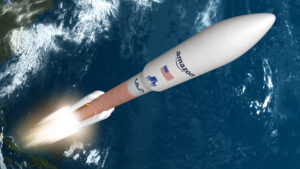However, Amazon must deploy half the low Earth orbit (LEO) constellation by July 2026 under regulatory conditions tied to its license. All the satellites have to be in place by July 2029.
“We’ve designed our satellites and dispenser system to accommodate multiple launch vehicles—this gives us the flexibility to use many different rockets and providers to launch our satellite system,” Project Kuiper vice president of technology Rajeev Badyal said.
“Atlas V is a capable, reliable rocket, and we’re proud to be working with ULA to support these important first launches.”
While SpaceX has been launching its Starlink broadband satellites in batches of 60, Amazon is not yet disclosing how many Kuiper spacecraft could be on one Atlas 5 mission.
The full Kuiper constellation will be deployed in five phases, according to regulatory filings. The first phase includes 578 satellites deployed at 630 kilometers altitude at an inclination of 51.9 degrees.
The Atlas 5 has been used to launch multiple national security and NASA missions, including the Perseverance Rover currently roaming Mars.
The rocket has a 100% success rate over more than 85 launches, according to Amazon.
The Atlas 5 missions for Kuiper will launch from Space Launch Complex 41 at the Cape Canaveral Space Force Station in Florida.
It is the first launch contract that Amazon has announced for Kuiper, although it is widely thought to be lining up Blue Origin, the rocket maker owned by Amazon CEO Jeff Bezos.
Amazon has insisted Blue Origin will compete with others for Kuiper launch contracts in the market, with the companies kept at arm’s length from each other.
The first launch of Blue Origin’s New Glenn rocket was recently pushed back to late 2022 after it lost a significant Pentagon contract last year.
LEO broadband development
Amazon has committed an initial $10 billion for Kuiper, and said April 19 that more than 500 people are now working on the program.
The company unveiled Dec. 16 what it describes as a low-cost, flat-panel Ka-band antenna, which will be part of the terminals used by Kuiper customers.
The company said in an April 19 blog post that its “team is heavily focused on inventing new technology to make broadband more affordable and more accessible for customers.”
SpaceX is currently offering Starlink beta testers a terminal that includes an antenna and router for $499, which the company is heavily subsidizing as it brings down the overall cost.
The cost of Starlink’s terminal is already less than half the $3,000 that SpaceX was originally paying for the equipment, according to company president and chief operating officer Gwynne Shotwell.
During an April 6 panel discussion at the Satellite 2021 LEO Digital Forum, Shotwell said she expects the “terminals coming in the few-hundred-dollar range within the next year or two.”
SpaceX is estimated to have more than 1,300 Starlink satellites in orbit amid a prolific launch campaign that lofted over 800 of them in 2020 alone.
Other LEO broadband entrants include OneWeb, which launched a batch of 36 satellites on a Soyuz-2.1b March 25 to bring its total to 146.
The venture, owned by the British government and Indian telecom company Bharti Global, is planning three more launches by June to cover north of 50 degrees latitude. That would expand coverage across the U.K., Alaska, Northern Europe, Greenland, Iceland, the Arctic Seas, and Canada.
Canadian satellite operator Telesat, which announced plans April 13 to raise $500 million in debt to develop its LEO broadband network Lightspeed, has early launch arrangements with Blue Origin and Relativity Space.
Relativity Space, which is building the world’s largest 3D printer to develop its rockets, also has yet to conduct an orbital launch.
Dan Goldberg, Telesat’s CEO, said April 6 he expects to finalize contracts in the next couple of months to start launching nearly 300 Lightspeed satellites from next year.



